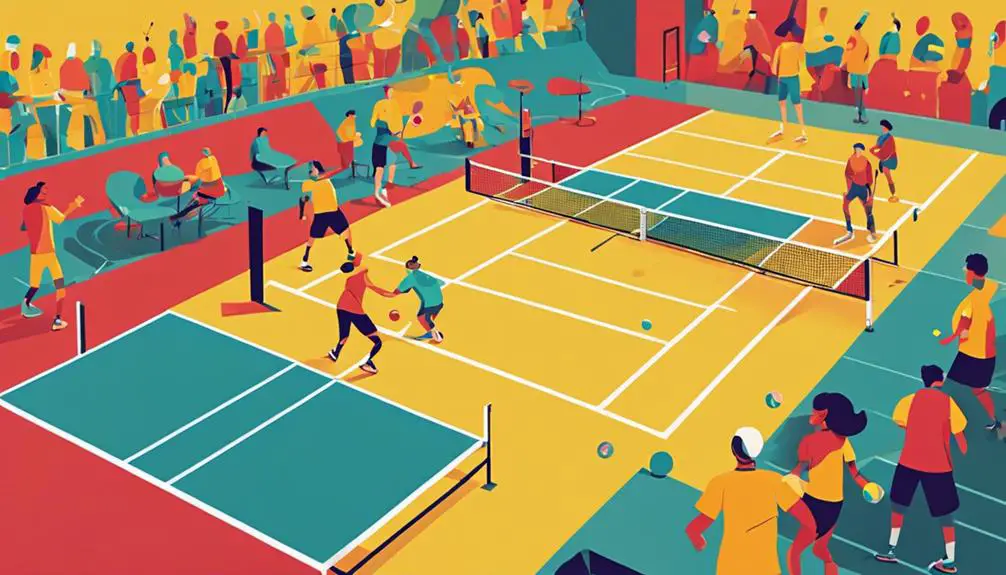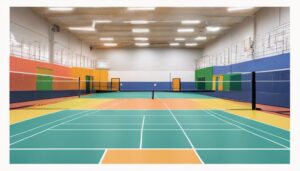When comparing pickleball and ping pong, you’ll find both sports have unique characteristics that cater to varying interests. Pickleball, combining elements of tennis and badminton, offers a fun, social atmosphere on smaller courts, making it accessible for all ages. In contrast, ping pong, a fast-paced game played on a table, emphasizes agility, precision, and quick reflexes. While pickleball focuses on teamwork and strategy, ping pong hones individual skills and offers intense rallies. Each has health benefits and a vibrant community. To truly understand what sets them apart, there’s more to explore, so keep going to uncover deeper insights.
Overview of Pickleball
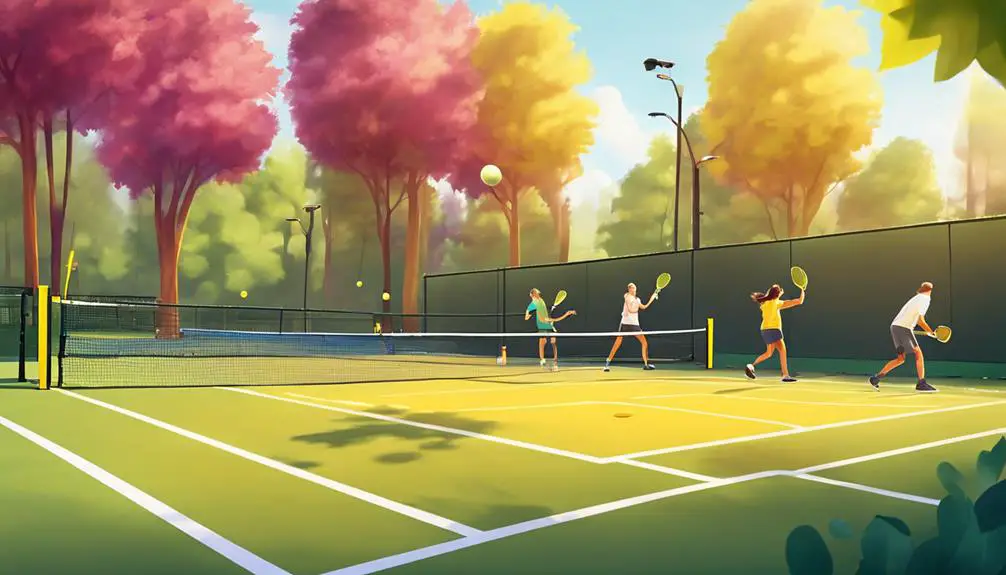
Playing pickleball offers a unique blend of fun and strategy, making it increasingly popular among various age groups. Its history dates back to 1965 on Bainbridge Island, Washington, where three dads sought to entertain their kids. They combined elements of tennis, badminton, and ping pong, creating a game that’s both accessible and engaging. This mixture of origins highlights how pickleball evolved from simple backyard fun to a structured sport with established rules.
As you explore the gameplay, you’ll notice how it incorporates both competitive and social elements. The court size is smaller than a tennis court, making it easier for players of all skill levels to engage. The lightweight paddles and plastic balls are designed for quick exchanges, fostering an environment where strategy plays a vital role. You’ll find that the game evolves with each match, adapting to the strengths and weaknesses of your opponents, which adds an exciting layer of tactical thinking.
Moreover, as pickleball’s popularity surges, its gameplay continues to evolve. New techniques and strategies emerge as players experiment with different styles. From serving tactics to shot placements, every match is an opportunity to learn and refine your skills. This dynamic nature not only enhances the enjoyment but also encourages a sense of freedom in how you approach the game. Fundamentally, pickleball is more than just a sport; it’s a celebration of creativity, community, and the joy of movement, appealing to anyone seeking a fulfilling recreational experience.
Overview of Ping Pong
While pickleball has carved out its niche in the world of sports, ping pong—officially known as table tennis—holds a longstanding legacy with its own unique appeal. Originating in the late 19th century as a parlor game in England, it quickly evolved into a competitive sport. Understanding the history overview of ping pong reveals how it transformed from a casual pastime to an Olympic event, enchanting players and fans alike.
At its core, ping pong is a test of agility, strategy, and precision. The game’s simple equipment—a lightweight paddle and a small plastic ball—belies the skill required to excel. Players must master various techniques, from spin serves to rapid counter-hits, making it both challenging and exhilarating. The rhythm of the game is frenetic, with points often won or lost in mere seconds.
Competitive tournaments play a significant role in the sport’s appeal. The International Table Tennis Federation (ITTF) governs these contests, organizing prestigious events like the World Championships and the Olympic Games. These tournaments showcase the top athletes from around the globe, fostering a spirit of camaraderie and fierce competition. Watching the world’s best players perform at these events can be a thrilling experience, as they push the boundaries of what’s possible with a small ball and a table.
Key Rules and Regulations
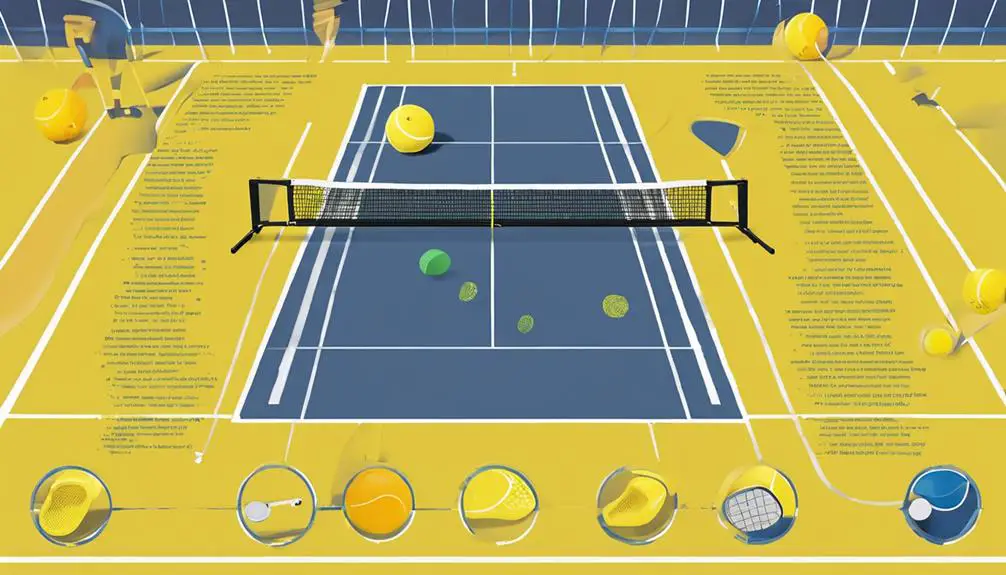
Understanding the key rules and regulations of ping pong is essential for anyone looking to engage with the sport at a competitive level. The game is played on a rectangular court, typically measuring 9 feet wide and 5 feet long, divided by a 6-inch-high net. Knowing these court dimensions helps you appreciate the strategic placement of your shots.
Scoring systems in ping pong can vary, but the most common format is the best of five or seven games, where a player must reach 11 points to win a game, with a two-point margin required. Familiarizing yourself with serve rules is important; the server must strike the ball behind the end line, and the ball must bounce on the opponent’s side before they return it.
Player positions also play a significant role in competitive play. Players often adopt a stance that maximizes their reach and agility, allowing for quick responses to opponents’ shots. There are various game variations, including singles and doubles, each with its own strategic nuances.
Tournament formats can differ, with some featuring round-robin play, while others use knockout stages. Knowing the format helps you prepare mentally and tactically.
Lastly, adhering to etiquette guidelines is essential in maintaining sportsmanship. This includes acknowledging good plays from opponents and avoiding distractions during play. By mastering these key rules and regulations, you can elevate your game and enjoy the freedom that comes with being a skilled ping pong player.
Equipment Comparison
The rules and regulations of ping pong highlight the importance of having the right equipment for peak performance. Choosing the ideal paddle types can greatly influence your game. You’ll find paddles made from various materials, each affecting speed and control differently. Meanwhile, understanding ball materials is vital; lightweight plastic balls are standard, but their construction impacts spin and durability.
When it comes to court dimensions, ping pong tables measure 9 feet long and 5 feet wide, with a net height of 6 inches. This specific setup requires you to adapt your playstyle accordingly. In contrast, pickleball courts are larger, demanding a different approach. Your footwear choices also play a role—opt for shoes that offer good grip and support, as both sports involve quick lateral movements.
Grip styles can vary between players, and finding what feels comfortable for you is essential. Whether you prefer a shakehand or penhold grip, make sure your paddle’s grip suits your technique. Additionally, consider investing in game accessories like paddle covers and ball storage containers to extend your gear’s lifespan.
Lastly, maintenance tips are often overlooked. Regularly clean your paddles and inspect your balls for wear and tear to keep your equipment in top shape. By prioritizing the right gear and maintenance, you’ll enhance your performance in ping pong while enjoying the freedom to play your way.
Playing Style and Strategy
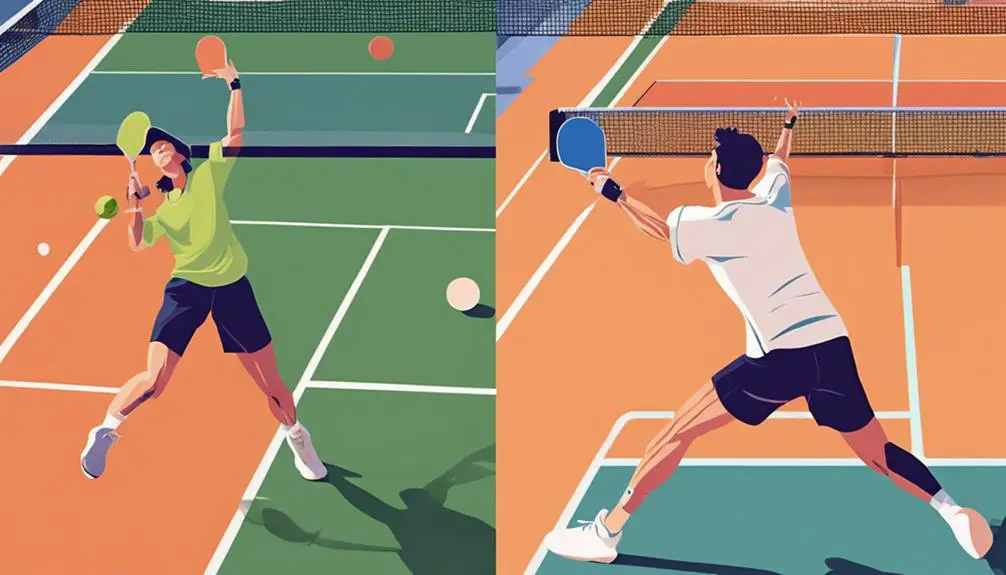
Adopting different playing styles can greatly impact your performance in both pickleball and ping pong. Each sport offers unique opportunities for players to showcase their skills through offensive strategies and defensive tactics. Understanding these nuances can elevate your game, allowing you to find your rhythm and play to your strengths.
Here’s a quick comparison of playing styles in both sports:
| Style | Pickleball Strategies | Ping Pong Strategies |
|---|---|---|
| Offensive | Fast volleys, aggressive serves | Spin-based attacks, quick rallies |
| Defensive | Dinking, controlling the pace | Blocking, counter-hitting |
| Mixed Approach | Switching between styles | Adapting to opponent’s weaknesses |
In pickleball, you might prefer an offensive approach, utilizing fast volleys and aggressive serves to put pressure on your opponent. You can also mix it up with defensive tactics like dinking to control the pace of the game, forcing your opponent to make mistakes.
Conversely, in ping pong, you could focus on spin-based attacks that leave your opponent scrambling. Here, quick rallies can make or break a match. If you find yourself on the defensive, honing your blocking and counter-hitting skills can turn the tide in your favor.
Ultimately, experimenting with various styles in both sports will help you discover what works best for your game, providing a sense of freedom and adaptability on the court.
Social Aspects of Each Sport
Many players find that the social aspects of pickleball and ping pong greatly enhance their experience on and off the court. In pickleball, you’ll discover a vibrant community where players of all skill levels engage with one another. This sport often emphasizes teamwork and camaraderie, which fosters social interaction and encourages players to form lasting friendships. Many pickleball clubs host social events, tournaments, and round-robin play, further promoting community engagement and making it easy for newcomers to join in.
On the flip side, ping pong, often played in more intimate settings like recreation centers or basements, offers its own unique social dynamic. The setup can lead to more personal interactions, allowing for one-on-one matches or small group games. While it may lack the larger community events common in pickleball, the close-knit atmosphere can create a sense of belonging among players. Regulars often gather at local clubs or cafes, forming tight bonds through consistent play.
Both sports provide ample opportunities for social engagement, but your preference may depend on how you enjoy connecting with others. If you thrive on community events and larger gatherings, pickleball might be your game. Conversely, if you prefer more personal interactions, ping pong could be the better fit. Ultimately, whether you’re smashing a ball or dinking it over the net, the social aspects of each sport enrich your experience, making each game not just about competition, but connection.
Health Benefits of Both Games
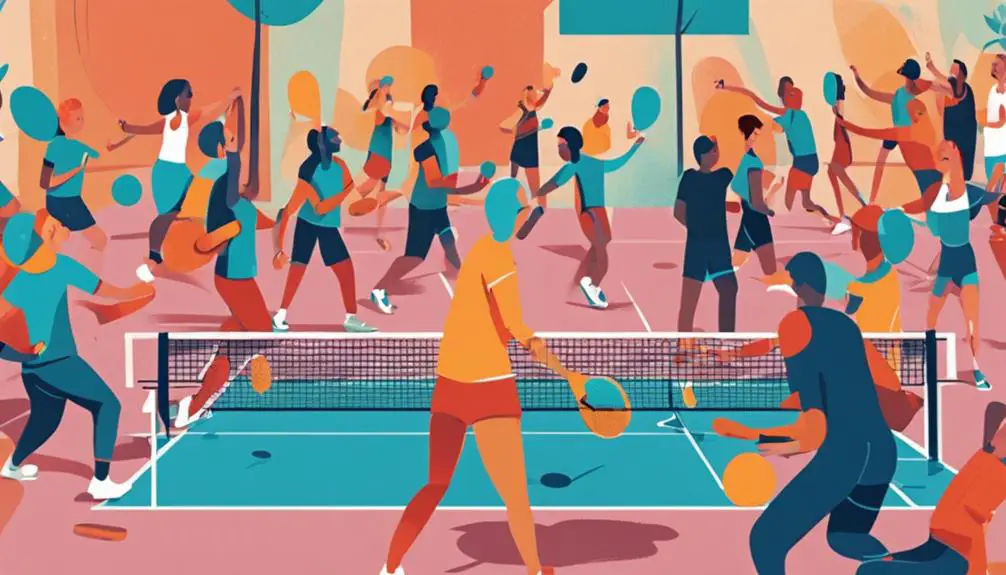
Engaging in either pickleball or ping pong offers a range of notable health benefits that can enhance your physical and mental well-being. Both sports provide excellent cardiovascular benefits, which is essential for maintaining heart health. When you engage in these fast-paced games, your heart rate increases, promoting better circulation and reducing the risk of cardiovascular diseases. This makes both sports effective workouts, allowing you to burn calories while having fun.
Moreover, both pickleball and ping pong can greatly boost your mental health. The focus required to keep up with the ball and strategize your next move encourages mindfulness, helping you to stay present in the moment. This mental engagement can alleviate stress and anxiety, providing a natural boost to your mood. In addition, the social interactions involved in both sports create a sense of community, which is important for emotional well-being.
Notably, pickleball’s larger court and dynamic gameplay can improve your agility, balance, and coordination, while ping pong sharpens your reflexes and hand-eye coordination. Both sports require quick thinking and adaptability, enhancing cognitive function over time.
Choosing the Right Sport for You
When deciding between pickleball and ping pong, it’s essential to take into account factors like your fitness goals, preferred social atmosphere, and physical abilities. If you’re looking for a sport with a gentler learning curve, ping pong might be your best bet. It’s often played indoors, making it accessible at any age, and the skill development can happen quickly, allowing for instant gratification.
On the other hand, if you want a more physically demanding game that encourages community engagement, pickleball could be ideal. With its larger courts and social playstyle, it offers numerous competitive opportunities, especially in local leagues. Plus, the expanding availability of outdoor courts means you can often find a game nearby.
Consider your age suitability, too. While both sports cater to a vast age range, pickleball tends to attract a more mature crowd, thanks to its lower impact and social nature. If you’re keen on making friends while staying active, pickleball’s vibrant community might be a perfect match.
Ultimately, think about what you want from your sport. Do you prefer the quick reflexes and strategic play of ping pong, or the social, engaging atmosphere of pickleball? Your choice should align with your personal goals and lifestyle. No matter what you choose, both sports offer a fulfilling way to stay active and connect with others.
Frequently Asked Questions
Can Pickleball Be Played Indoors and Outdoors?
Yes, you can play pickleball indoors and outdoors. Indoor benefits include controlled conditions and reduced weather interference, while outdoor challenges like wind and sun can affect gameplay. Choose your setting based on your preferences and goals.
What Is the History Behind the Game of Pickleball?
You’ll find pickleball originated in 1965, created by three dads seeking a fun family activity. Over time, its game evolution transformed it into a popular sport, embracing a diverse community that enjoys its energetic nature.
Are There Professional Pickleball Tournaments?
Think of professional pickleball tournaments as vibrant arenas where skilled players showcase their talent. These events feature various tournament formats, allowing professional players to compete fiercely, elevating the sport’s excitement and giving fans an unforgettable experience.
How Do I Find Local Pickleball Clubs?
To find local pickleball clubs, explore local resources like community centers or sports websites. Engaging with the pickleball community, whether online or in person, can also lead you to clubs and fellow enthusiasts nearby.
What Are Common Injuries Associated With Ping Pong?
Imagine a rapid rally, where wrist sprains can sneak up on you, and your eyes dart like a hawk. Common injuries in ping pong include wrist sprains and eye injuries, highlighting the sport’s thrilling, yet demanding nature.

